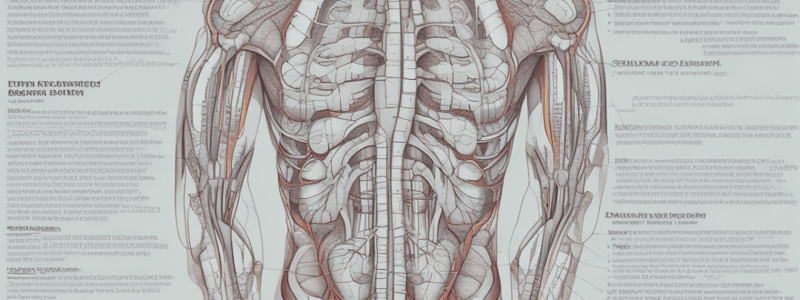Podcast
Questions and Answers
Match the condition with its description:
Match the condition with its description:
Hernias = Abnormal protrusion of the bowel through a weakening in the abdominal muscles Bladder prolapse = Condition where the pelvic floor muscles and ligaments weaken resulting in the bladder dropping Rectocele = Hernia of the rectum Perineum = In females the area between the anus and vagina; in men the area between the anus and scrotum
Match the action with its description:
Match the action with its description:
Testicular Self-Exam = Inspecting the testicles looking for any lumps, swelling, or anything unusual Genitalia Self-Exam = Instruct anyone who is sexually active to look at all regions of genitalia and educate them on signs/symptoms of STIs Barlow-Ortolani maneuver = Assess hip stability in newborns Syndactyl & polydactyl = Syndactyl refers to conjoined webbed fingers or toes; Polydactyl means having extra toes or fingers
Match the term with its meaning:
Match the term with its meaning:
Symmetry = Everything is evenly proportioned or balanced Asymmetry = Means something may not be normal or unproportioned, uneven (facial drooping, lesion) Bilateral = Means on both sides Unilateral = Means on one side
Match the following terms related to spinal deformities with their descriptions:
Match the following terms related to spinal deformities with their descriptions:
Match the following terms related to knee deformities with their descriptions:
Match the following terms related to knee deformities with their descriptions:
Match the following terms related to foot deformities with their descriptions:
Match the following terms related to foot deformities with their descriptions:
Match the following terms related to joint movement assessment with their descriptions:
Match the following terms related to joint movement assessment with their descriptions:
Match the following terms related to bone density with their nutritional requirements:
Match the following terms related to bone density with their nutritional requirements:
Match the following types of arthritis with their characteristics:
Match the following types of arthritis with their characteristics:
Match the following terms with their correct definitions:
Match the following terms with their correct definitions:
Match the following symptoms with their respective medical conditions:
Match the following symptoms with their respective medical conditions:
Match the following descriptions with the correct medical terms:
Match the following descriptions with the correct medical terms:
Match the following signs with their corresponding conditions:
Match the following signs with their corresponding conditions:
Match the following terms with their definitions:
Match the following terms with their definitions:
Match the following terms with their descriptions:
Match the following terms with their descriptions:
Match the nutrition concepts with their descriptions:
Match the nutrition concepts with their descriptions:
Match the dietary guidelines with their recommendations:
Match the dietary guidelines with their recommendations:
Match the behaviors with their descriptions:
Match the behaviors with their descriptions:
Flashcards are hidden until you start studying




